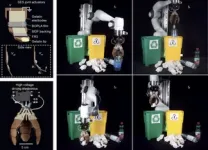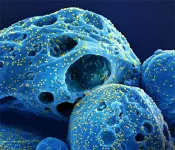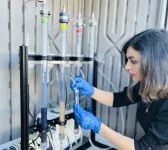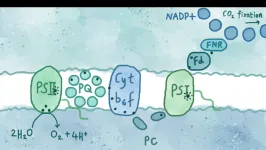(Press-News.org)
Stuttgart, Linz, Boulder – Artificial muscles are a progressing technology that could one day enable robots to function like living organisms. Such muscles open up new possibilities for how robots can shape the world around us; from assistive wearable devices that can redefine our physical abilities at old age, to rescue robots that can navigate rubble in search of the missing. But just because artificial muscles can have a strong societal impact during use, doesn’t mean they have to leave a strong environmental impact after use.
The topic of sustainability in soft robotics has now been brought into focus by an international team of researchers from the Max Planck Institute for Intelligent Systems (MPI-IS) in Stuttgart (Germany), the Johannes Kepler University (JKU) in Linz (Austria), and the University of Colorado (CU Boulder), Boulder (USA). The scientists collaborated to design a fully biodegradable, high performance artificial muscle – based on gelatin, oil, and bioplastics. They show the potential of this biodegradable technology by using it to animate a robotic gripper, which could be especially useful in single-use deployments such as for waste collection (watch the Youtube video). At the end of life, these artificial muscles can be disposed of in municipal compost bins; under monitored conditions, they fully biodegrade within six months.
“We see an urgent need for sustainable materials in the accelerating field of soft robotics. Biodegradable parts could offer a sustainable solution especially for single-use applications, like for medical operations, search-and-rescue missions, and manipulation of hazardous substances. Instead of accumulating in landfills at the end of product life, the robots of the future could become compost for future plant growth,” says Ellen Rumley, a visiting scientist from CU Boulder working in the Robotic Materials Department at MPI-IS. Rumley is co-first author of the paper “Biodegradable electrohydraulic actuators for sustainable soft robots” which will be published in Science Advances on March 22, 2023.
Specifically, the team of researchers built an electrically driven artificial muscle called HASEL. In essence, HASELs are oil-filled plastic pouches that are partially covered by a pair of electrical conductors called electrodes. Applying a high voltage across the electrode pair causes opposing charges to build on them, generating a force between them that pushes oil to an electrode-free region of the pouch. This oil migration causes the pouch to contract, much like a real muscle. The key requirement for HASELs to deform is that the materials making up the plastic pouch and oil are electrical insulators, which can sustain the high electrical stresses generated by the charged electrodes.
One of the challenges for this project was to develop a conductive, soft, and fully biodegradable electrode. Researchers at Johannes Kepler University created a recipe based on a mixture of biopolymer gelatin and salts that can be directly cast onto HASEL actuators. “It was important for us to make electrodes suitable for these high-performance applications, but with readily available components and an accessible fabrication strategy. Since our presented formulation can be easily integrated in various types of electrically driven systems, it serves as a building block for future biodegradable applications,” states David Preninger, co-first author for this project and a scientist at the Soft Matter Physics Division at JKU.
The next step was finding suitable biodegradable plastics. Engineers for this type of materials are mainly concerned with properties like degradation rate or mechanical strength, not with electrical insulation; a requirement for HASELs that operate at a few thousand Volts. Nonetheless, some bioplastics showed good material compatibility with gelatin electrodes and sufficient electrical insulation. HASELs made from one specific material combination were even able to withstand 100,000 actuation cycles at several thousand Volts without signs of electrical failure or loss in performance. These biodegradable artificial muscles are electromechanically competitive with their non-biodegradable counterparts; an exciting result for promoting sustainability in artificial muscle technology.
“By showing the outstanding performance of this new materials system, we are giving an incentive for the robotics community to consider biodegradable materials as a viable material option for building robots”, Ellen Rumley continues. “The fact that we achieved such great results with bio-plastics hopefully also motivates other material scientists to create new materials with optimized electrical performance in mind.”
With green technology becoming ever more present, the team’s research project is an important step towards a paradigm shift in soft robotics. Using biodegradable materials for building artificial muscles is just one step towards paving a future for sustainable robotic technology.
______
The Science Advances paper titled “Biodegradable electrohydraulic actuators for sustainable soft robots” (DOI: 10.1126/sciadv.adf5551), was co-authored by Ellen H. Rumley, David Preninger, Alona Shagan Shomron, Philipp Rothemund, Florian Hartmann, Melanie Baumgartner, Nicholas Kellaris, Andreas Stojanovic, Zachary Yoder, Benjamin Karrer, Christoph Keplinger, and Martin Kaltenbrunner.
END
Below is a brief roundup of news and story ideas from the experts at UCLA Health. For more information on these stories or for help on other stories, please contact us at uclahealthnews@mednet.ucla.edu.
Journal scan
Mixed ancestry study provides clues to genetic traits A new multi-institutional study led by scientists at the Bioinformatics Interdepartmental Program at UCLA has found that individuals of mixed ancestry, such as African Americans, inherit a mosaic of ancestry segments from ...
Nitroxoline is the name of the new drug candidate that could potentially be used to treat mpox. It was identified by scientists at Goethe University and the University of Kent as part of a multi-site study. The results of their research will now allow clinical trials to begin soon.
The current mpox outbreak is the first of this size to occur outside of Africa and also the first mpox outbreak caused by human-to-human transmission. People with immunodeficiencies are particularly at risk from the disease. Although antiviral agents have already been shown to inhibit the replication ...
The COVID-19 pandemic has killed nearly 7 million people worldwide (1.1 million in the United States) and severely harmed many millions more, though vaccines and antiviral treatments measurably reduced the potential loss of life and health.
A Commonwealth Fund report, for example, estimated COVID-19 vaccines alone prevented more than 18 million additional hospitalizations and 3.2 million additional deaths in the U.S.
The pandemic has never been simple or easy. For example, the emergence of viral variants, in particular recent versions of the Omicron, fueled new surges of infection and disease throughout 2022 and into 2023.
“There were real concerns ...
ITHACA, N.Y. -- A model system created by stacking a pair of monolayer semiconductors is giving physicists a simpler way to study confounding quantum behavior, from heavy fermions to exotic quantum phase transitions.
The group’s paper, “Gate-Tunable Heavy Fermions in a Moiré Kondo Lattice,” published March 15 in Nature. The lead author is postdoctoral fellow Wenjin Zhao in the Kavli Institute at Cornell.
The project was led by Kin Fai Mak, professor of physics in the College of Arts and Sciences, and Jie Shan, professor of applied and engineering physics in Cornell Engineering ...
Indiana University School of Medicine is accepting nominations until May 1 for the 2024 August M. Watanabe Prize in Translational Research.
The Watanabe Prize is one of the nation’s largest and most prestigious research awards recognizing senior investigators focused on shepherding scientific discoveries into new therapies for patients. Nominees should be members of the scientific or medical communities who have demonstrated outstanding accomplishments in translational research.
The winner will receive $100,000 and will spend Sept. 18-20, 2024, in Indianapolis as a vising dignitary, sharing insights and knowledge with audiences at IU School of Medicine and its partner institutions. ...
Dr. Ekta Khurana, an associate professor of physiology and biophysics at Weill Cornell Medicine, has received a 3-year, $1.2 million grant from the United States Department of Defense to investigate how prostate cancer cells evolve to become resistant to hormone-blocking therapy. This work will contribute to further understanding prostate cancer and the development of effective targeted therapies for the disease.
Prostate cancer growth is dependent on androgens – male hormones such as testosterone – binding ...
Engineers at the University of British Columbia have developed a new water treatment that removes “forever chemicals” from drinking water safely, efficiently – and for good.
“Think Brita filter, but a thousand times better,” says UBC chemical and biological engineering professor Dr. Madjid Mohseni, who developed the technology.
Forever chemicals, formally known as PFAS (per-and polyfluoroalkyl substances) are a large group of substances that make certain products non-stick or stain-resistant. There are more than ...
Researchers have ‘hacked’ the earliest stages of photosynthesis, the natural machine that powers the vast majority of life on Earth, and discovered new ways to extract energy from the process, a finding that could lead to new ways of generating clean fuel and renewable energy.
An international team of physicists, chemists and biologists, led by the University of Cambridge, was able to study photosynthesis – the process by which plants, algae and some bacteria convert sunlight into energy – ...
Photos // Video
The push toward truly autonomous vehicles has been hindered by the cost and time associated with safety testing, but a new system developed at the University of Michigan shows that artificial intelligence can reduce the testing miles required by 99.99%.
It could kick off a paradigm shift that enables manufacturers to more quickly verify whether their autonomous vehicle technology can save lives and reduce crashes. In a simulated environment, vehicles trained by artificial intelligence perform perilous maneuvers, forcing the AV to make decisions that confront drivers only rarely on ...
A new study suggests that a common genetic signature may increase a person’s risk of developing substance use disorders, regardless of whether the addiction is to alcohol, tobacco, cannabis or opioids. The research, led by Washington University School of Medicine in St. Louis, eventually could lead to universal therapies to treat multiple substance use disorders and potentially help people diagnosed with more than one.
Published March 22 in the journal Nature Mental Health, the study’s findings are drawn from an analysis of genomic data from more than 1.1 million people of mostly European ancestry and a smaller ...






